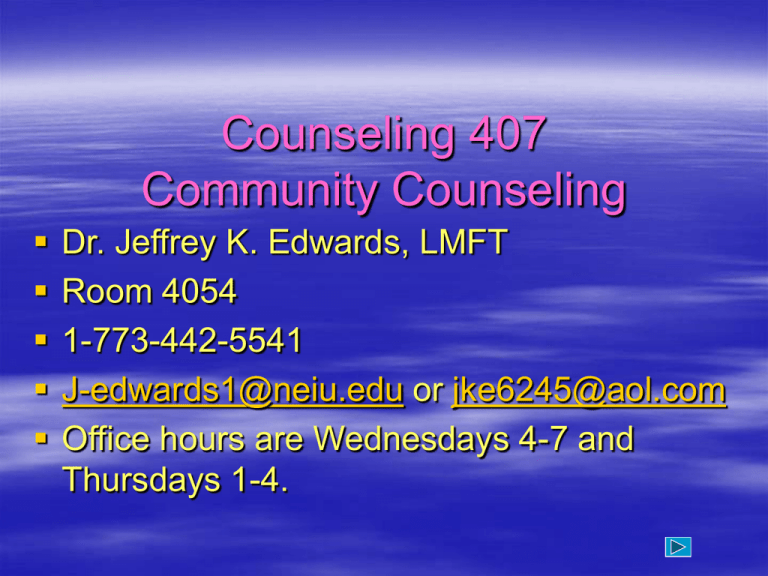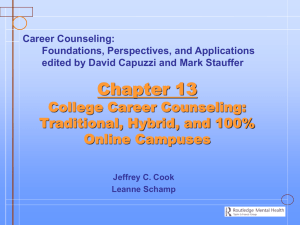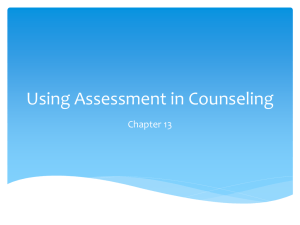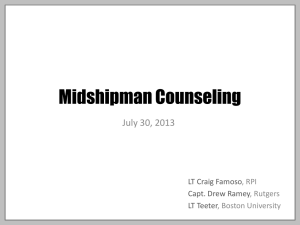Community Counseling
advertisement

Counseling 407 Community Counseling Dr. Jeffrey K. Edwards, LMFT Room 4054 1-773-442-5541 J-edwards1@neiu.edu or jke6245@aol.com Office hours are Wednesdays 4-7 and Thursdays 1-4. Counseling 407 Community Counseling Day one – Introduction Counseling research – Review or new? Community Counseling - Definitions Prevention - Models Counseling Knowledge Well-known facts that most therapists either overlook, forget, or were never told. Or, why counseling/psychotherapy myths about who is better prevail. Arm yourself with this information and you will be an unstoppable Community/Family Counselor. Counseling Knowledge this will wake you up. Counseling and or Psychotherapy are comparatively the same thing. They are simply different names for doing the same activities. However, there are many professionals who have been trained to believe that doing psychotherapy is more scientific and rigorous, and should only be provided by certain professions. (For a comprehensive review see Neukrug, 2003) Counseling Knowledge this will wake you up. Counseling/Psychotherapy works. More than 40 years of outcome studies have demonstrated effectiveness (Hubble, Duncan and Miller, 1999). However, nearly 50% of clients drop out of treatment. There are few predictors of premature dropout, except substance abuse, minority status, and lower education (Prochaska, 1999). Counseling Knowledge Smith et al. (1980) found that at the end of treatment, clients were better off than 80% of a control group that did not have treatment. Two studies showed that about 75% of clients significantly improve after 26 sessions (six months) and that 50% show significant improvement after only 8 to 10 sessions. Counseling Knowledge In fact, the average length of stay in treatment is around 8 to 10 sessions, with a modal number of 1. In a famous research project at Keiser Permenante 80% of those clients who dropped out after one session, however, reported that they had received the help they needed after that one session. Counseling Knowledge Certain types of client problems are more likely to relapse, notably those with substance abuse problems, eating disorders, recurrent depression, and personality disorders (Asay and Lambert, 1999). It seems, however that change is more likely to last, if the client attributes their changes to their own efforts ( Lambert & Bergin, 1994). When therapy succeeds, the convention is to attribute the positive outcome to the therapy or ministrations of the therapist. In contrast, when therapy goes awry, or at least yields disappointing results, it has been customary to place the failure in the client or the client’s personality (Hubble, Duncan, & Miller, 1999). Counseling Knowledge 1. Counseling/Psychotherapy models all have the same effectiveness, more or less (see comprehensive reviews in Hubble, Duncan and Miller, 1999; Seligman, 1995). 2. This has been called the Dodo effect, by Luborsky et al. (1975) - from Alice and Wonderland, “Everyone has won and all must have prizes.” Counseling Knowledge Effective therapy can be achieved in short periods of time (5 to 10 sessions) with at least 50% of clients seen in routine clinical practice. A sizable minority (20% to 30%) requires treatment lasting more than 25 sessions. Those clients who are more likely to fail at brief therapy efforts are those who are poorly motivated, hostile, have poor relationships with others in their life. Counseling Knowledge Techniques that are critical, attacking, rejecting, blaming etc. Are less effective treatments (Najavits & Strupp, 1994) Therapies that focus on the future, instill hope early on, and enhance the clients hope and placebo effect are more effective (Asay & Lambert, 1999) OK now, what does all this mean to you? How does this change the way you will practice? What ideas do you have for changing the way you thought you might work? What excites you about these concepts? Counseling Knowledge If techniques are not that important, then what are the factors that contribute to positive outcome? There are four: 1. Client Variables (40%); 2. The Therapeutic relationship (30%); 3. Expectancy and Placebo Effect (15%); 4. Technique (15%). Counseling Knowledge Common Factors in Counseling Technique 15% Expectancy (placebo Effect 15% Theraputic Relationship 30% Extratheraputic Change 40% Client Variables (40%) 1. Severity of Symptoms (both psychological and physical); 2. Motivation; 3. Psychological mindedness; 4. Ability to identify a focal problem (Lambert and Anderson, 1996). Client Variables (40%) 1. Such things as insight, and acquisition and practice of new behaviors are also components of the therapy that can and should be attributed to the client, perhaps upping the 40% as high as 70% of the variable. Client Variables (40%) “a withdrawn, alcoholic client, who is ‘dragged into therapy’ by his or her spouse, possesses poor motivation for therapy, regards ,mental health professionals with suspicion, harbors hostility toward others, is not nearly as likely to find relief as the client who is eager to discover how he or she has contributed to a failing marriage and expresses determination to make personal changes” (Asay and Lambert, 1999). The Therapeutic Relationship (30%) Spontaneous Improvement “a significant number of people are helped by friends, family, teachers, and clergy who use a variety of supportive and HOPE instilling techniques. Howard et. al (1986) estimated that about 15% of clients experience some improvement before the beginning of treatment” (Asay & Lambert, 1999). The Therapeutic Relationship (30%) Spontaneous Improvement is influenced by 1. Length of time the problem has been evident; 2. Underlying personality disorder; 3. Quality of social support, especially the marital relationship (Andrews & Tennant, 1978; Mann, Jenkins, & Belsey, 1981). The Therapeutic Relationship (30%) The Necessary and sufficient conditions Accurate Empathy Positive Regard Non possessive warmth Congruence and genuineness. These are client-perceived rather than objective raters’ perceived. The Therapeutic Relationship (30%) There is significant research to show that years of experience are not necessarily correlated with effectiveness (Christiansen & Jacobson, 1994), while some studies have shown that self-help literature are in some cases of equal benefit as therapy (Gould & Clum, 1993). The Therapeutic Relationship (30%) It seems that the following components are important to the therapeutic alliance: Client’s affective relationship with the therapist; Client’s capacity to work purposefully in therapy; Therapist’s empathic understanding and involvement; Client-therapist agreement on goals and tasks of therapy (Gaston, 1990). The Therapeutic Relationship (30%) In the NIMH Study of Depression Collaborative Research Program (1996), a comparison between psychotherapy and active and placebo pharmacology found that the therapeutic alliance had a significant effect on outcome. So what do you think about that? The Therapeutic Relationship (30%) During a demonstration of “bad” therapy techniques I did at Wheaton College, I demonstrated bad posture, bad eye contact, etc. When done, I asked the class to evaluate, and they were correct in their perceptions of my techniques, however, the “client” saw things differently. She said it was the most profound experience of her life!! Expectancy and Placebo Effect (15%) Frank (1973) has suggested that people only seek help when they have become demoralized because of their own inability to solve their problems. They feel powerless over their own life situations. Consistent research has demonstrated that a large portion of improvement occurs during the first 3 to 4 weeks of therapy, with 40 to 60% change occurring before the client has their first interview (Weiner-Davis, deShazer & Gingrich, 1987). Expectancy and Placebo Effect (15%) In summarizing several studies, Lambert, Weber, & Sykes, (1993) have shown that the average client in therapy undergoing a placebo treatment will have a better outcome than 60% of a no-treatment group. Expectancy and Placebo Effect (15%) In several studies with medications, the placebo effect has been demonstrated to be even greater than the 15% usually assumed (Benson & McCallie, 1979). Expectancy and Placebo Effect (15%) In a now classic study (Feldman, 1956) the effectiveness of chlorpromazine was prescribed by two groups of psychiatrists with the following results - Those who were enthusiastic had a 77% success rate, while those who did not (psychodynamic) only achieved a 10% success rate. Expectancy and Placebo Effect (15%) The finding that drug efficacy relates to prescribing physician attitudes has been replicated repeatedly (Scovern, 1999). Technique (15%) Basing the following on the consistent research findings that different types or models of therapy have relatively the same outcome, a number of points are made. First, that training in specific models and techniques is pointless (Strop & Anderson (1997), and that staying true to a protocol manual does not prevent a wide variety of outcomes from the different therapists using them (Luborsky et al. Technique (15%) Of more concern, and reported more in the research is the finding that staying true to a manual may cause other factors such as flexibility, warmth, and the therapeutic alliance (see Ogles, Anderson, & Lunnen, 1999). These problems along with a multiplicity of others, causes a great deal of concern when one regards the current trends by the American Psychiatric Association, Managed Care Models of Psychotherapy Used at Internship Sites National Structural 1% N = 854 Adlerian 1% Behavioral 14% Solution 19% Brief Strategic 8% Reality 6% Client Centered 9% Psychody 10% Narrative 1% Cognitive 18% Jungian 0% Family Systems 13% Stages of Change James Prochaska Precontemplation – Contemplation – Preparation Action Maintenance – Termination - Precontemplation – are not intending to change, or take action, usually in terms of “the next 6 months.” Are not fully informed, or aware of consequences. May have tried to change in the past without success. No inherent motivation to change Contemplation – People intend to change within the next 6 months. Are aware of pros and cons of change vs. no change. Profound ambivalence. Preparation Plan to take action within the next month. Have taken some action in the past year. Have a plan for action. These are the best people to recruit for action oriented treatment. Action Have made specific, overt modifications in their lifestyles within the past 6 months. Behavior change has been equated with the action stage. Outcomes depend on neither the duration of therapy nor the education or experience of the therapist. Maintenance – Working to prevent relapse, lasts from 6 months to 5 years. Failure usually is associated with being under prepared for the length of time maintenance takes. The average American drinks, eats, smokes, and takes drugs to manage distress (Mellinger, Balter, Manheimer, Cisin, and Perry, 1978). People struggling to overcome chronic conditions will be at the greatest risk of relapse. Counseling Knowledge Medications Beecher (1955) reviewed 15 single or double bind studies that looked at the effects of placebos on a variety of conditions. He concluded that on average and across studies, placebos produced ‘satisfactory relief’ in 35% of those treated (Scovern, 2001) Counseling Knowledge Since the mid 1980’s there has been an 275% increase of persons who have trained and provide counseling/psychotherapy. There still has not been a reduction in any of the psychological or psychiatric “illnesses.” A Community Counseling Model The Upstream Model A Model of Community Counseling This is the story of the Jeffrey’s River – Once upon a time, there was a river named Jeffrey. I wonder why? A Model of Community Counseling One day …someone came floating .. A Model of Community Counseling down the river, almost drown. A Model of Community Counseling A good Samaritan saw the drowning person Help! A Model of Community Counseling helped him out and saved his life. Thanks A Model of Community Counseling Soon, another person came floating down the river, almost drown. Help! A Model of Community Counseling and he too, was helped out and had his life saved. Thanks A Model of Community Counseling soon there were lots and lots of people coming down the river drowning. Help! Help! Help!Help! Please!! A Model of Community Counseling The Samaritan needed some help. So he asked a friend. Help! Help! Help!Help! Please!! A Model of Community Counseling And soon there were lots and lots of people helping all those other people coming down the river drowning. A Model of Community Counseling Soon they were building hospitals, and clinics…. A Model of Community Counseling And then they had supervisors and administrators… A Model of Community Counseling And they had overseers who told them how much they would pay…called Managed Care. A Model of Community Counseling And then one very smart person decided to go up stream to see….. A Model of Community Counseling what or who was causing all those people to fall in the river. It is me. I like to push them into the drink. A Model of Community Counseling And he told him to stop. So, he did! Hey, stop that! OK, I will. A Model of Community Counseling And that is how a Preventative Public Health model was born…. Thanks. You are welcome. The Dawn of a New Day Salaries for therapists went through a shift. During the “Golden Days” (1980’s) of psychotherapy, the cost of a service hour went to around $90.00. Now, the rate has changed "if you look up the creek in any weather, your spirit fills, and you are saying, with an exulting rise of the lungs, "Here it comes!" There must be something wrong with a creekside person who, all things being equal, chooses to face downstream. It's like fouling your own nest. For this and a leather couch they pay fifty dollars an hour?...Look upstream Just simply turn around; have you no will? The future is a spirit, or a distillation of the spirit, heading my way. Annie Dillard, Pilgrim at Tinker Creek, 1974 Cost per capita for Individual Counseling You do the math. If you can see 30 clients a week at $90 per hour, or see 100 client for four hours at $100 per hour, several times a week, who gets the better deal? Community Counseling Components A new model of mental health/behavioral health needs to be designed so that services can be equitable for all. The community has all the resources needed to provide for it’s members; Public Health Concepts Is the mental health system set up to help those who need it the most? Or is it set up to subsidize the upper and upper middle classes? Community Counseling is set up to help those in need, and who are under-represented by service delivery. They way mental health systems are set up now, is to provide services to the less needy, and to make more money for the providers of services. This is not a just way of operating. Prevention Public Health came about from the work of Health Care professionals, like Physicians, Nurses and other professionals, who study epidemiology, and they then find ways to treat groups who have similar problems. Epidemiology – 1. a branch of medical science that deals with the incidence, distribution, and control of disease in a population ; 2 : the sum of the factors controlling the presence or absence of a disease or pathogen . Examples of Epidemiology and Prevention Work Snow, Edwin Miller – America's first professional city medical health officer he, took on the serious problems with cholera epidemic of 1854 in Providence, in which he investigated about 150 cases. There was no health authority in the city, so he personally undertook action to curb the epidemic. He drew up a report sharply criticizing the city's complete lack of sanitary precautions and recommended measures to deal with the problem. Examples of Epidemiology and Prevention Work SIDS – 50% reduction of deaths by placing babies on their backs. SIDS – with Native Americans – did not respond in kind, but further investigation found that many mothers were also binge drinking, and by swaddling the babies in the colder months so they get too hot. Examples of Epidemiology and Prevention Work The nations highways are safer now because of epidemiology and Public Health concepts. The director of National Highways was a PH Doc, and he studied the roadways where there were a preponderance of vehicular accidents. After serious consideration, the roads were banked to allow cars to travel at the existing speeds without running off of the road. Community Counseling Components Mental Health and Mental Illness: A Public Health Approach – Surgeon General Report: http://www.surgeongeneral.gov/library/ment alhealth/chapter1/sec1.html Definitions of Prevention The classic definitions used in public health distinguish between primary prevention, secondary prevention, and tertiary prevention (Commission on Chronic Illness, 1957). Primary prevention is the prevention of a disease before it occurs; secondary prevention is the prevention of recurrences or exacerbations of a disease that already has been diagnosed; and tertiary prevention is the reduction in the amount of disability caused by a disease to achieve the highest level of function. Surgeon Generals Report, 2002 The Institute of Medicine report on prevention identified problems in applying these definitions to the mental health field (IOM, 1994a). The problems stemmed mostly from the difficulty of diagnosing mental disorders and from shifts in the definitions of mental disorders over time. Consequently, the Institute of Medicine redefined prevention for the mental health field in terms of three core activities: prevention, treatment, and maintenance (IOM, 1994a). The Institute of Medicine report on prevention Prevention, according to the IOM report, is similar to the classic concept of primary prevention from public health; it refers to interventions to ward off the initial onset of a mental disorder. Treatment refers to the identification of individuals with mental disorders and the standard treatment for those disorders, which includes interventions to reduce the likelihood of future co-occurring disorders. The Institute of Medicine report on prevention (IOM, 1994a). And maintenance refers to interventions that are oriented to reduce relapse and recurrence and to provide rehabilitation. (Maintenance incorporates what the public health field traditionally defines as some forms of secondary and all forms of tertiary prevention.) Critique of a medical definition of Mental Health Prevention Albee (1993) has suggested that Public Health measures have done more to provide the population with good health and the eradication of disease than conventional medical interventions. Public health relies on larger scale preventions; no one-on-one therapy has ever eradicated a disease. Critique of a medical definition of Mental Health Prevention Those who are in power have decided that all human problems are organic (brain problems, either in structure or chemically) control how reimbursement will occur (through the use of DSM) rather than seeing them as social, psychological or interact ional problems (Albee, 1993). Critique of a medical definition of Mental Health Prevention The conventional medical system has much to gain financially by using the individual treatment model (Albee, 1993). The organic Assignment for next week. Read the first two chapters in your book. Do a library search on Ovid/PsychLit re: Prevention in Mental Health limited between 1980 and 2000 (20 years). Look for trends and begin to look critically at the topics.








